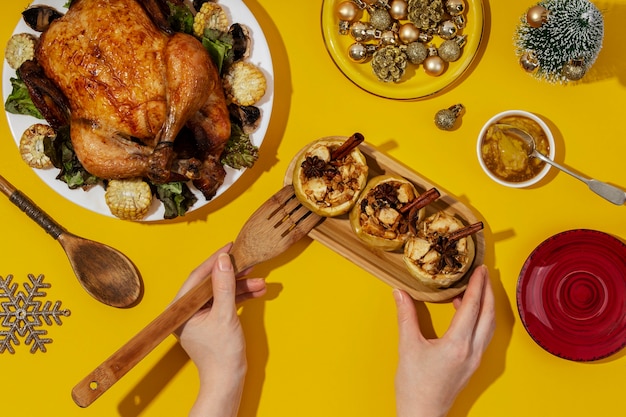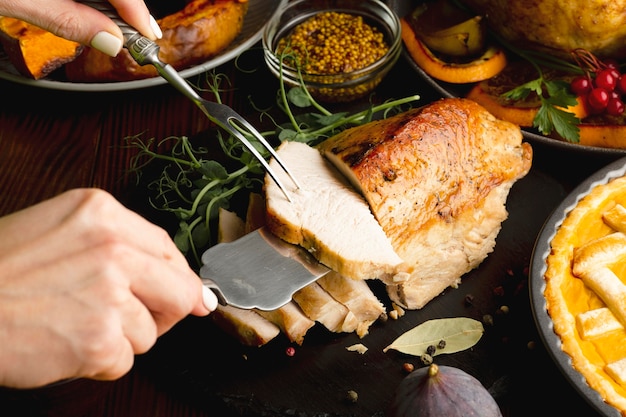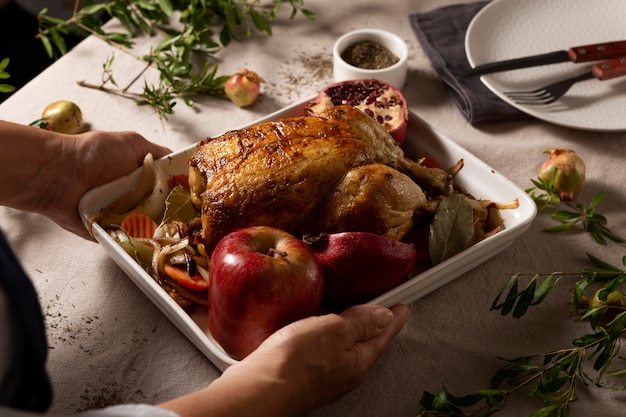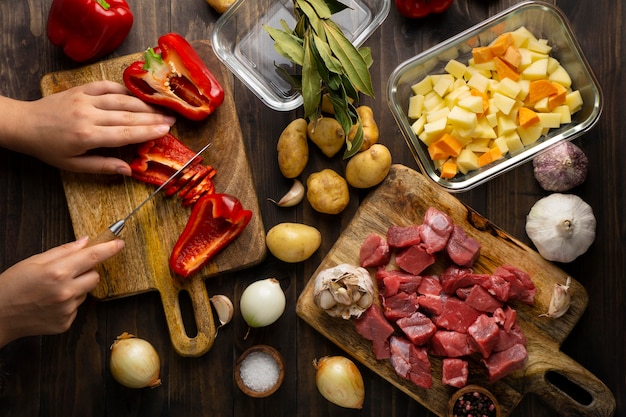Right, let’s talk turkey, shall we? Not the bird itself, mind you, but how to cook it to absolute perfection. I’m not talking about that dry, rubbery thing you get at a Christmas buffet – I’m talking succulent, juicy, and flavour-packed. And trust me, it's easier than you think.
This is the culmination of years of turkey-roasting experience, trial and error, and a healthy dose of festive cheer. We're going to cover everything from choosing the right bird to carving it like a pro, leaving you with the confidence to tackle any turkey with aplomb. So, grab a cuppa, settle in, and let's get this feast rolling!
(Part 1) Choosing Your Turkey

Picking the Perfect Bird
The first step in any great turkey adventure is finding the right bird. There are two main types: fresh and frozen. I’m a firm believer in fresh turkeys – they just have a better flavour. If you’re going for fresh, make sure it feels firm to the touch, has a good colour (a healthy pink, not grey), and smells fresh, not sour.
When choosing a fresh turkey, look for one with clear skin and no signs of bruising or discoloration. Avoid any turkeys that have a strong, unpleasant odour.
Size Matters
Next, consider the size. You need to factor in how many people you're feeding. A good rule of thumb is about 1 pound (450g) of turkey per person. But remember, these are just guidelines. If you have big appetites, go for a bigger bird.
If you’re unsure about the size, ask your butcher for advice. They’ll be able to help you choose the right size turkey for your needs.
Going Organic?
Organic turkeys are a great choice if you're looking for a more ethical and sustainable option. They often have more flavour too. However, they can be more expensive, so factor that into your budget.
Beyond the Basics: Turkey Types
There are different types of turkeys available, each with its own unique characteristics. Here are a few to consider:
Heritage Turkeys: These turkeys are raised in a more traditional way, often on pasture, and tend to have a deeper flavour than commercially raised turkeys. They can be a bit pricier, but worth it for the quality.
Broad-Breasted White Turkeys: These are the most common type of turkey found in supermarkets. They are bred for large breasts, but can be a bit dry if not cooked properly.
Bronze Turkeys: These turkeys have a distinctive bronze plumage and are known for their rich flavour. They are also a good source of protein and iron.
Free-Range Turkeys: These turkeys have access to outdoor space and are typically raised on a diet of grains and grasses. They are often considered more humane and can have a more flavorful meat.
(Part 2) Prepping Your Turkey

Brining for the Win
Brining is a game-changer. It involves soaking the turkey in a salt-water solution for several hours, which helps to keep the meat moist and flavourful. It's not essential, but I highly recommend it – your taste buds will thank you.
Here's how to brine a turkey:
1. Make the Brine: Dissolve 1 cup of kosher salt and 1 cup of brown sugar in 1 gallon of cold water. You can add extra flavour to your brine with herbs, spices, citrus fruits, or even a bit of alcohol (like apple cider or brandy).
2. Soak the Turkey: Place the turkey in a large container and pour the brine over it, making sure it’s completely submerged. Cover the container and refrigerate for 12-24 hours.
3. Rinse and Dry: After brining, rinse the turkey thoroughly with cold water and pat it dry with paper towels.
Let's Get the Butter Under the Skin
A good way to boost the flavour and keep the meat juicy is to slip some butter under the skin of the turkey. Don't worry, it's easier than it sounds. Gently lift the skin away from the breast and thighs, creating a little pocket to slip the butter into. Then, spread it around evenly. It's a great way to add flavour and keep the meat succulent.
You can also use herbs and spices in your butter mixture. Try rosemary, thyme, sage, garlic, or paprika for a flavour boost.
Seasoning Sensations
Once you’ve buttered up the bird, it's time to season. I like to keep it simple with salt, pepper, and maybe a sprinkle of herbs like rosemary or thyme.
For extra flavour, try rubbing the turkey with a mixture of herbs and spices. You can create your own blend or use a pre-made poultry seasoning.
Time to Truss
Trussing is basically tying the legs and wings of the turkey together to ensure even cooking. If you’re feeling ambitious, you can do it yourself with string or cooking twine. But if you’re not a fan of knots, you can always buy a pre-trussed turkey.
Here’s how to truss a turkey:
1. Tie the Legs: Cross the turkey's legs and tie them together with twine.
2. Tie the Wings: Fold the wings behind the turkey's back and secure them with twine.
3. Tie the Breast: Optionally, you can tie the breast with twine to help it cook evenly.
(Part 3) Cooking Your Turkey to Perfection

Oven Ready
Preheat your oven to 325°F (165°C). You want a slow and steady cooking process to ensure the turkey cooks through evenly and stays juicy.
Stuffing the Bird?
If you’re stuffing your turkey, make sure you do it right before putting it in the oven. This helps prevent the stuffing from getting soggy. And remember, stuffing should always be cooked to an internal temperature of 165°F (74°C).
You can cook the stuffing separately in a casserole dish for a safer and more evenly cooked dish.
Turkey Time!
Place the turkey in a roasting pan and add a cup of water to the bottom. This will help to keep the turkey moist and prevent it from drying out.
Pro Tip: You can add vegetables like carrots, onions, and celery to the roasting pan for extra flavour. These will also add to the stock you can make later from the drippings.
Cook Time!
The cooking time for a turkey depends on its weight. A good rule of thumb is to calculate 15 minutes per pound (450g) for an unstuffed turkey, and 20 minutes per pound for a stuffed turkey. But the best way to know if it's cooked through is with a meat thermometer.
Here's a helpful table for approximate cooking times:
| turkey weight | Unstuffed Cook Time | Stuffed Cook Time |
|---|---|---|
| 10-12 lbs | 2.5-3 hours | 3-3.5 hours |
| 12-14 lbs | 3-3.5 hours | 3.5-4 hours |
| 14-16 lbs | 3.5-4 hours | 4-4.5 hours |
| 16-18 lbs | 4-4.5 hours | 4.5-5 hours |
Important Note: These are just estimates. Always check the internal temperature of your turkey with a meat thermometer to ensure it’s cooked through.
Resting is Key
Once the turkey is cooked, let it rest for at least 30 minutes before carving. This allows the juices to redistribute, resulting in a juicier and more flavorful bird.
You can cover the turkey loosely with foil while it rests. This will help to keep it warm and moist.
(Part 4) Carving Your Turkey like a Pro
The Tools of the Trade
You'll need a sharp carving knife and a good cutting board. I like to use a carving fork to hold the turkey steady while I cut.
If you don’t have a carving knife, a sharp chef's knife will do the trick. Just be careful to use it with caution.
Starting the Carve
Begin by cutting the drumstick and thigh from the turkey. Use your carving knife to cut through the joint, then carefully remove the drumstick and thigh. Repeat on the other side.
The Breast
Next, remove the breast meat. Slice the breast along the bone, then carefully remove it from the bone. You can then carve the breast into slices.
Pro Tip: To avoid tearing the meat, use a sawing motion with your knife.
Serving Time
Now you've got a beautifully carved turkey, ready to be enjoyed by everyone. Serve it with all your favourite sides and don't forget the gravy!
(Part 5) Gravy: The Finishing Touch
Making the Gravy
Good gravy is essential for any turkey dinner. It’s what makes the whole thing come together. I like to make my gravy from the turkey drippings.
The Dripping Details
Once you’ve removed the turkey from the roasting pan, pour off the fat into a heat-proof container. Leave the turkey drippings in the pan.
You can use the turkey fat for making other dishes later, like roasted potatoes or vegetables.
The Flour Factor
Add 2-3 tablespoons of flour to the pan and whisk it into the drippings until it’s smooth.
Adding the Stock
Gradually whisk in about 2 cups of turkey or chicken stock, or even water if you’re feeling adventurous. Bring to a simmer and cook for a few minutes, stirring constantly, until the gravy thickens.
Pro Tip: If your gravy is too thick, add a bit more stock. If it’s too thin, whisk in a bit more flour.
Strain It
Strain the gravy through a fine-mesh sieve to remove any lumps.
Season and Serve
Season with salt and pepper to taste and serve over your delicious turkey.
(Part 6) Leftover Turkey? No Problem!
turkey sandwiches
Who doesn’t love a turkey sandwich? Use your leftover turkey, some bread, and your favourite condiments for a quick and easy lunch or snack.
turkey soup
Leftover turkey is perfect for a hearty soup. Just chop it up and add it to your favourite soup recipe.
turkey salad
Mix your leftover turkey with mayonnaise, celery, onion, and a dash of salt and pepper for a delicious turkey salad.
turkey pot pie
Make a comforting turkey pot pie using your leftover turkey and a flaky pastry crust.
Turkey Shepherd's Pie
For a twist on a classic, use leftover turkey to make a shepherd's pie.
Beyond the Basics
Here are some other ideas for using up leftover turkey:
Turkey Chili: Add chopped turkey to your favourite chili recipe.
Turkey Pizza: Top a pizza crust with leftover turkey, cheese, and your favourite toppings.
Turkey Enchiladas: Use leftover turkey to fill tortillas and bake them for a delicious and easy meal.
(Part 7) A Feast for the Senses
The Feast
Now, it’s time to gather everyone around the table and enjoy the fruits of your labour. A delicious, perfectly cooked turkey, accompanied by all your favourite side dishes and a generous helping of gravy.
The Side Dish Selection
No turkey feast is complete without a selection of side dishes. I'm a big fan of classic sides like mashed potatoes, stuffing, cranberry sauce, and green bean casserole. But you can really go wild with your sides and choose whatever you like.
Here are some additional side dish ideas:
Roasted Vegetables: Try Brussels sprouts, carrots, parsnips, or sweet potatoes.
sweet potato casserole: A delicious and comforting side dish that pairs well with turkey.
Mac and Cheese: A classic crowd-pleaser.
Cornbread: A traditional southern side that adds a sweet and savory touch to your meal.
Dessert Delight
No celebration is complete without a delicious dessert. Apple pie, pumpkin pie, pecan pie, or even a simple fruit salad – the options are endless.
(Part 8) FAQs
1. How do I know if my turkey is cooked through?
The best way to tell if your turkey is cooked through is with a meat thermometer. Insert it into the thickest part of the thigh, making sure it doesn't touch any bone. It should read 165°F (74°C).
2. What if my turkey is overcooked?
If your turkey is overcooked, it will be dry and rubbery. There's not much you can do to salvage it, but you can try to add some moisture back by basting it with gravy or butter.
3. What do I do with the turkey carcass?
Don't throw it away! You can use it to make a delicious turkey stock. Just simmer it in water with some vegetables and herbs for a few hours.
4. Can I freeze leftover turkey?
Yes, you can freeze leftover turkey. Just wrap it tightly in plastic wrap or foil and freeze for up to 3 months.
5. Is it safe to eat turkey that’s been sitting out at room temperature?
No, it’s not safe to eat turkey that’s been sitting out at room temperature for more than two hours. Bacteria can grow quickly at room temperature, so it’s important to keep your turkey refrigerated or in a cooler until you’re ready to eat it.
(Part 9) The Final Word
So there you have it, my ultimate guide to cooking a perfect whole turkey. It might seem daunting at first, but trust me, with a little planning and some practice, you can create a delicious and impressive feast that will have everyone singing your praises. Just remember to relax, have fun, and enjoy the process. After all, it's all about sharing a special meal with loved ones. Happy cooking!
Everyone is watching

Perfect Rice Every Time: The Ultimate Guide to Cooking Rice
Cooking TipsAs a self-proclaimed foodie, I've always been a bit obsessed with rice. It's the foundation of countless cuisi...

Ultimate Guide to Cooking the Perfect Thanksgiving Turkey
Cooking TipsThanksgiving. Just the word conjures up images of overflowing tables laden with delicious food, the scent of r...

The Ultimate Guide to Cooking Asparagus: Tips, Techniques, and Recipes
Cooking TipsAsparagus. The mere mention of this spring delicacy conjures up images of vibrant green spears, crisp and burs...

Can You Cook Spaghetti with Gasoline? (The Shocking Truth)
Cooking TipsWe've all seen those crazy internet trends. You know, the ones that make you wonder, "Did someone actually try...

Chorizo and Eggs Recipe: The Ultimate Guide
Cooking TipsRight, let’s talk about chorizo and eggs. You know, that classic Spanish dish that's always a winner. It's th...
